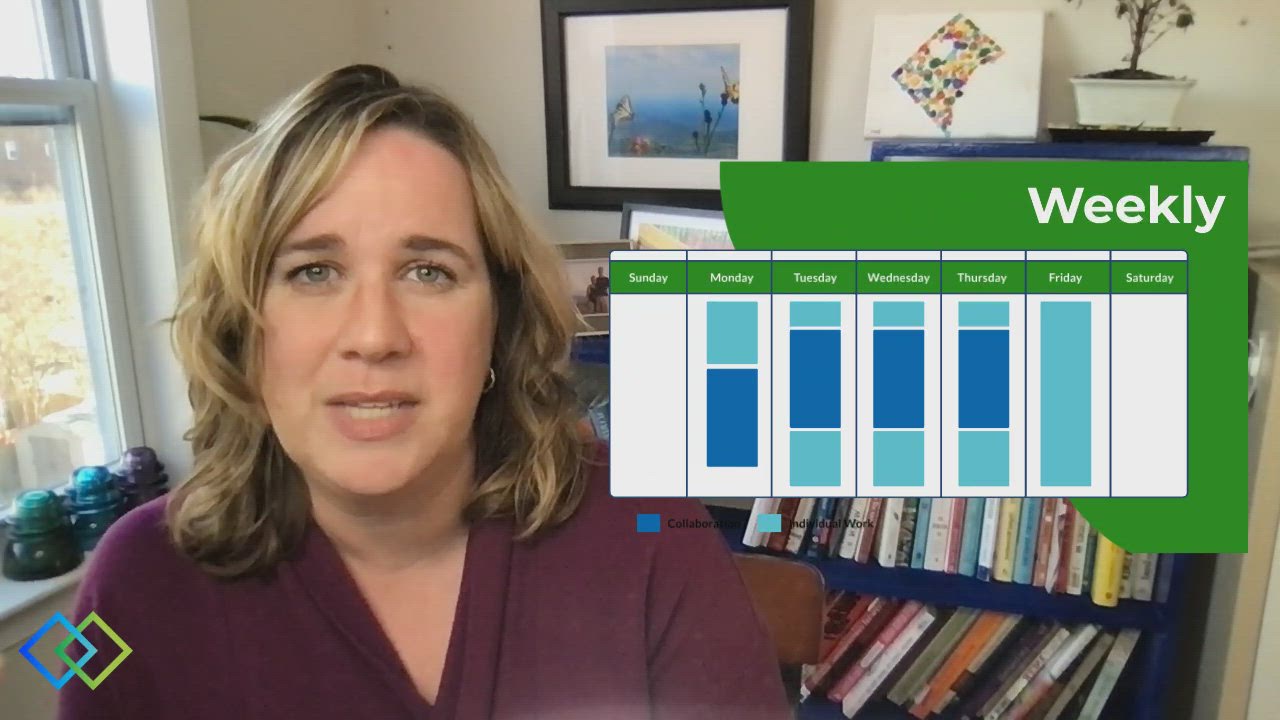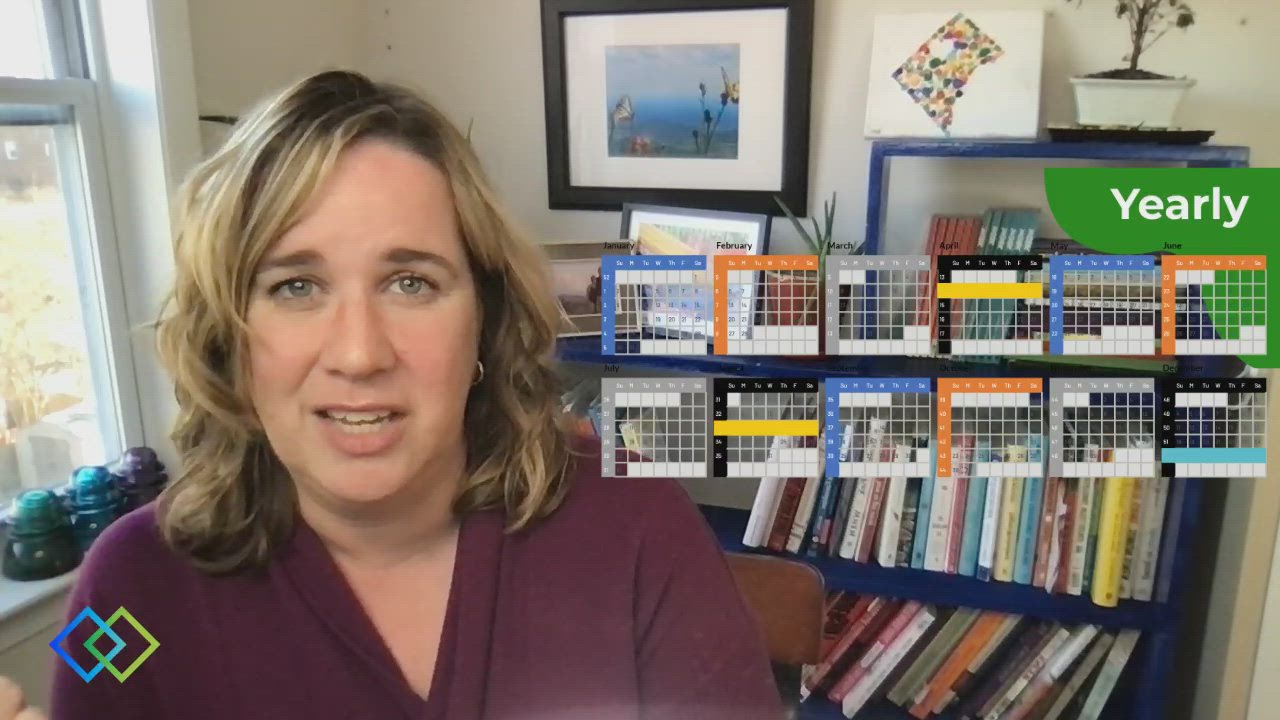Audio Transkript automatisch generiert
- 00:00 - 00:02
working remotely has given us many benefits
- 00:02 - 00:05
no more long commutes flexibility in our workday
- 00:05 - 00:07
and the ability to juggle other priorities.
- 00:07 - 00:09
And it comes with downsides too.
- 00:09 - 00:12
Chief among them is this blur between our workspaces and home making it
- 00:12 - 00:16
feel like we're never not working because our offices have become our homes.
- 00:16 - 00:18
Our computers are always a few paces away.
- 00:19 - 00:21
We're also missing the camaraderie that comes from bumping
- 00:21 - 00:23
into colleagues in the office face to face,
- 00:23 - 00:24
brainstorming sessions,
- 00:24 - 00:27
casual conversations while video technology gives us the
- 00:27 - 00:29
ability to collaborate from anywhere in the world.
- 00:29 - 00:31
It's okay to admit that it's not the same in
- 00:31 - 00:35
too many hours staring into screens inevitably leads to burnout.
- 00:35 - 00:36
Is there a solution?
- 00:36 - 00:39
Is there a way to work well individually and together and
- 00:39 - 00:42
reduce the likelihood of burnout in a virtual or hybrid environment
- 00:43 - 00:46
at match pace? We called the solution pace sync scheduling.
- 00:47 - 00:48
When we talk about pace at work,
- 00:48 - 00:52
we mean the established rhythms and expectations of our workday week, work year,
- 00:52 - 00:56
how hard you're working when and when you can ease up or rest.
- 00:56 - 00:59
We are all about organizations running at a healthy sustainable
- 00:59 - 01:01
pace and they should run at the same pace,
- 01:01 - 01:02
a match pace or a sink.
- 01:02 - 01:05
Pace organizations can create agreed upon blocks of
- 01:05 - 01:07
time for how teams organize their days,
- 01:07 - 01:09
weeks, months and years.
- 01:09 - 01:10
Think of these as the core hours,
- 01:10 - 01:12
Your team plans on doing certain types of
- 01:12 - 01:15
work together and individually wherever they're working from.
- 01:16 - 01:19
Part of burnout right now is because we don't know what we're doing? When
- 01:19 - 01:23
should we be available? All the time with colleagues across different time zones?
- 01:23 - 01:25
Which time zone are we operating in?
- 01:25 - 01:27
Can we ever put our heads down and work?
- 01:28 - 01:31
When should we dedicate time during the workday
- 01:31 - 01:34
to engage in intentional collaboration and synergy while protecting
- 01:34 - 01:37
other times for deep focus and creativity and protecting
- 01:37 - 01:39
even other times for really being able to unplug
- 01:40 - 01:41
pace,
- 01:41 - 01:44
sinking can codify which days teammates are expected to work
- 01:44 - 01:46
from which location in a hybrid environment as well.
- 01:47 - 01:49
Here's an example of how pace thinking could work.
- 01:49 - 01:51
You start by thinking about the type of work you
- 01:51 - 01:53
do and what kind of environment you need to do it
- 01:53 - 01:57
and then you build a cadence of blocks for those types of work.
- 01:57 - 02:01
So say you do a lot of collaborative work, you prioritize that in your core hours.
- 02:01 - 02:04
Then you need time for some uninterrupted individual work and you put that
- 02:04 - 02:06
on your team's calendar so they know they can count on it.
- 02:07 - 02:10
It's not a bad idea to throw in a weekly no video day.
- 02:10 - 02:13
So people can schedule meetings that don't need videos and know they
- 02:13 - 02:15
can have space where they definitely don't need to be camera ready
- 02:16 - 02:16
with pace.
- 02:16 - 02:19
Thinking you can maximize the benefits of using video because you're
- 02:19 - 02:22
using it when it's most valuable and not when it's not.
- 02:23 - 02:24
So your week starts to look like this,
- 02:25 - 02:26
Then you add in monthly days
- 02:26 - 02:29
for all in days where the local team needs to work from
- 02:29 - 02:32
the office for meetings or trainings that are better done in person
- 02:34 - 02:36
and then airplane days, do you remember when we had laptops,
- 02:36 - 02:39
but no wifi on airplanes and you could get so much work done.
- 02:39 - 02:41
Consider a day like that for your team.
- 02:42 - 02:44
Then your month starts to look like this.
- 02:44 - 02:47
And you can add some annual blocks like quiet weeks where you block
- 02:47 - 02:50
off from client meetings to give your team to be heads down together.
- 02:50 - 02:54
And if you're able to even add in a week or two where you're all off simultaneously,
- 02:54 - 02:55
that would be great
- 02:57 - 03:00
pay sinking allows your team to know when they need to be in which kind of mode
- 03:01 - 03:03
it drives your team to be more intentional with how
- 03:03 - 03:05
they use meetings and how they focus their attention.
- 03:06 - 03:08
There are a few important things to point out
- 03:08 - 03:12
pace thinking can only be set from a team or organizational level.
- 03:12 - 03:14
Individual employees can't set this kind of schedule.
- 03:14 - 03:18
Leadership does it with an eye on employee needs client needs,
- 03:18 - 03:20
the type of work the team has to do.
- 03:20 - 03:24
So everyone can be on the same page. It wouldn't work for one person to schedule.
- 03:24 - 03:26
They're focused time on Tuesdays from 8 to 11
- 03:26 - 03:28
and someone else on Tuesdays from 12 to 3.
- 03:28 - 03:30
It can only be done by looking at the whole picture
- 03:30 - 03:33
and with leadership leading the charge and that's the second thing
- 03:33 - 03:35
to point out is that everyone actually has to do this.
- 03:35 - 03:38
You can't have the ceo pounding out emails to
- 03:38 - 03:41
everyone during what is supposed to be quiet time.
- 03:41 - 03:44
Um And then the biggest challenges that an organization
- 03:44 - 03:46
needs to be crystal clear in its priorities.
- 03:47 - 03:49
Burnout comes not just from working too many hours,
- 03:49 - 03:51
but also from having too many priorities that fracture a
- 03:51 - 03:54
person's attention and make it hard to get work done.
- 03:54 - 03:58
This isn't about trying to get out about the same amount of work done or even more.
- 03:58 - 04:02
But I got about getting specifically the right work done
- 04:02 - 04:05
and dip prioritizing things that aren't associated with the mission.
- 04:06 - 04:09
When we talk about changing how we work the number of hours or the structure,
- 04:09 - 04:11
the conversation we really need to be having
- 04:11 - 04:14
is which work is important and which work isn't
- 04:14 - 04:17
pace thinking can be helpful for all organizations,
- 04:17 - 04:20
but it's critical for remote or hybrid organizations.
- 04:20 - 04:22
They set realistic expectations for how and
- 04:22 - 04:25
when will collaborate and more importantly,
- 04:25 - 04:28
when they won't protecting time for focus and preventing burnout,
- 04:28 - 04:31
ultimately sinking your pace is one powerful tool to help your
- 04:31 - 04:34
team work well together from different locations and time zones.
- 04:34 - 04:38
It can help combat burnout and video fatigue and help
- 04:38 - 04:41
your team set boundaries that protect their priorities outside of work
- 04:41 - 04:42
a match pace.
- 04:42 - 04:46
We love helping organizations discover the right pace for them because it works.
- 04:46 - 04:50
Teams are more focused, more creative, less fractured, more engaged.
- 04:50 - 04:51
If you're interested in learning more.
- 04:51 - 04:54
Drop me a note Elizabeth at match pace dot net,
- 04:54 - 04:56
or try taking one of the ideas that you heard
- 04:56 - 04:58
in this video and piloting it with your team.
- 04:58 - 04:59
I would love to hear how it works out.















